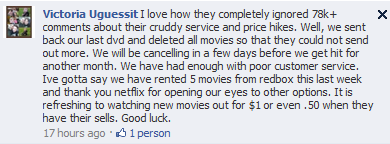 In my last post, I examined how Netflix’s communication style contributed to the problems they’ve been struggling with since July. In this post, I’ll cover a few of the social media blunders Netflix committed throughout this communication spiral.
In my last post, I examined how Netflix’s communication style contributed to the problems they’ve been struggling with since July. In this post, I’ll cover a few of the social media blunders Netflix committed throughout this communication spiral.
I firmly believe rules are meant to be broken. But there are some rules—even in the ever-changing social media world—that you’re better off following or being really sure you understand the repercussions if you don’t.
In Netflix’s case, they committed two ginormous no-nos after announcing their new pricing on July 12: saying nothing and deleting posts.
No-No # 1: Saying NOTHING When the Doo-Doo Hits the Fan
Forty-eight hours after announcing the pricing changes on Facebook, Netflix had yet to respond to the 65,000+ people who commented on their wall in the first two days. And followers noticed as well, and were still voicing their opinion seven days later.
Netflix’s silence was equally deafening on their blog.
No-No # 2: Deleting Wall Posts
There have been many blog posts since the pricing announcement that Netflix was removing followers’ comments from their Facebook wall. And there were even more comments on their wall complaining about earlier comments being removed. According to a post on MSNBC’s Technolog, Steve Swasey, vice president of corporate communications at Netflix, says the company wasn’t deleting comments.
If they were, shame on them—unless the ones they deleted had profanity, etc. If they weren’t, then why not speak up? Address the accusation. Say something. And while at it, address the entire pricing situation (see no-no # 1 above).
An Extra No-No: Not Allowing Commenting on Blog Posts
While doing research for this post, I was spending time on Netflix’s blog and noticed an odd occurrence. There are no comments for any of the posts between July 27 and October 30 (except one on October 4); nor does there appear to be anyway to comment on them either. If you access the July 27 post or any others before then, an abundance of comments display, with a “Post a Comment” link at the bottom—same for the September 27 post. However, no such link is included on any other posts since July 27, including the September 18 apology and the post on DVDs staying at Netflix.com.
The removal of commenting on the blog could be a technical glitch, but it’s an odd one if it is. I explored a few of the recent posts that had comments in more depth. And the one on October 4 (“Power, Deception and Lies Plus Other Good Stuff”) shows that comments have been disabled for this post by a blog administrator.
 So, it looks like Netflix has decided not to allow commenting. As Julia Roberts said in Pretty Woman, “Big mistake. Big. Huge.”
So, it looks like Netflix has decided not to allow commenting. As Julia Roberts said in Pretty Woman, “Big mistake. Big. Huge.”
Social media is two-way communication. If you don’t want a dialogue and only want to push information out to the masses, stay away from social media. Period. If you don’t, you’ll likely find yourself in a Netflix-like situation at some point.
Better Choices to Make If You Find Yourself in Netflix’s Position
- Have a plan. Before announcing anything big, have a plan for handling possible negative comments, so you can respond.
- Respond immediately. Even if you don’t have a plan, be prepared to respond quickly with something—even if it’s just to say, “We hear you, and we’re working on a solution.” Your top priority for the next however many hours it takes should then be writing an apology and explanation, developing a plan for monitoring and managing the communication, and working out alternatives to what you announced, if that’s an option.
- Don’t act as if the backlash isn’t happening. The ostrich approach never works.
- Don’t delete. Don’t delete. Don’t delete. Did I mention you shouldn’t delete negative comments, unless inappropriate, like fowl language. In that instance, make sure you’re clear about why—that it’s not the negative comment, it’s the choice of words used that resulted in the removal.
- Avoid any additional big changes/announcements until you address the current problem.
- Keep commenting enabled even when the comments are unpleasant.
- Monitor all the time and have staff on hand to respond. If you’re as well known as Netflix with 2,000,000+ people (roughly 1.5M in July) liking your Facebook page, you can’t afford to not monitor the social media conversation constantly—and respond regularly.
- Use your social media channels to capture the pulse of your customers before making big changes. Poll people. Find people with whom you can test the waters. Employ crowdsourcing.
Before closing this post, I should note that not all the comments on Netflix’s Facebook page are disparaging. There are some who would say the complainers are just loud but not the majority.
But with social media, it doesn’t really matter if the naysayers are in the minority. It can still tarnish your image and damage your relationship with customers—both of which take time to rebuild.
Will Netflix come out of this? I think they will, but they have a long road ahead of them to repair the damage that’s been done.





